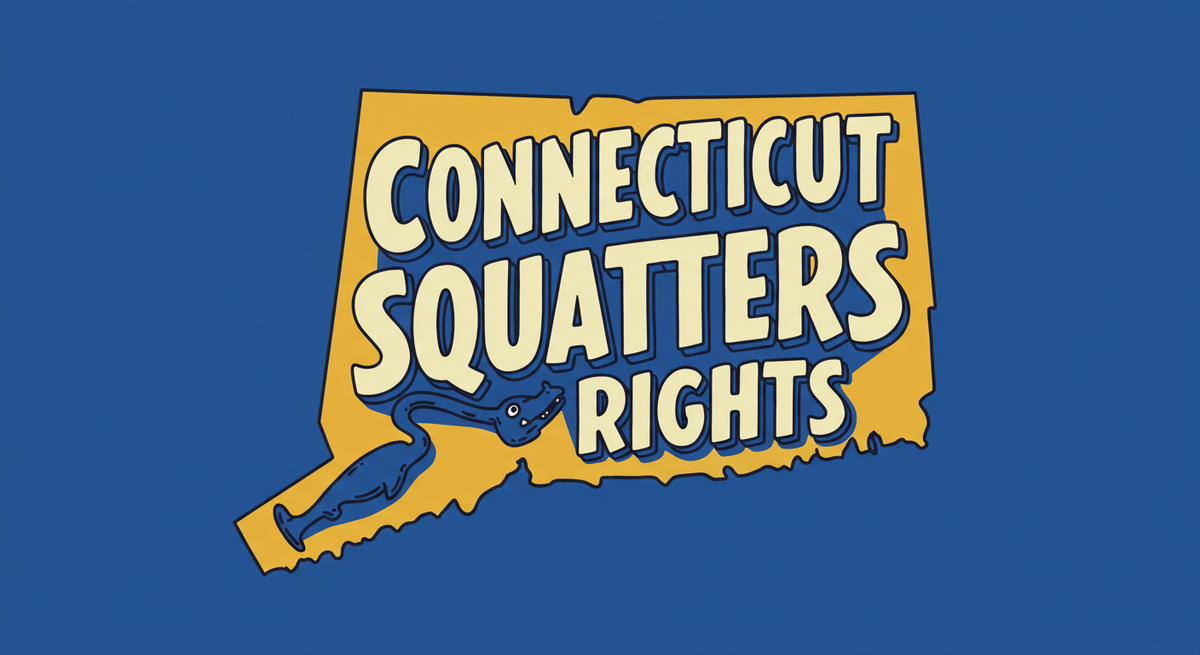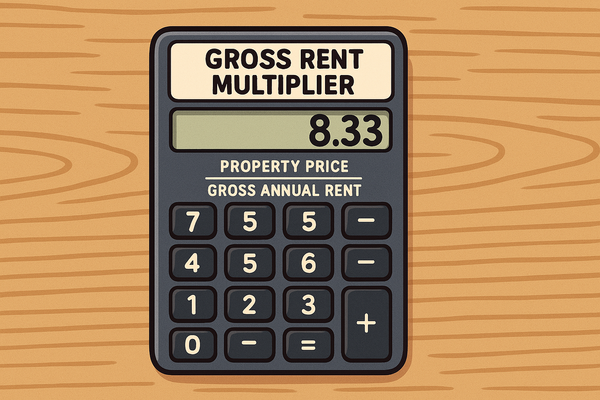Connecticut Squatter's Rights Guide: 2025 Laws and Property Protection
Connecticut requires squatters to occupy property continuously for 15 years before they can file an adverse possession claim

Squatter Definition: A squatter is someone who occupies a property without the owner's permission and sometimes even claims legal ownership.
Interesting Fact: In Connecticut, family photographs and videos can serve as crucial evidence in adverse possession cases. In Carter v. Yampanis (2008), old family photos showing long-term use of a disputed property area proved pivotal in establishing a successful adverse possession claim. Your family vacation photos could actually become legal evidence in property disputes!
In Connecticut, it's important for landlords and property owners who want to protect their investments to fully grasp the laws surrounding unauthorized property occupation (re: adverse possession claims), especially given the state's relatively short 15-year statutory period.
Key Takeaways
- Connecticut requires squatters to occupy property continuously for 15 years before they can file an adverse possession claim
- Property owners must provide written notice to squatters to disrupt the adverse possession timeline
- Connecticut follows the OCEAN requirements for adverse possession: Open, Continuous, Exclusive, Actual, and Notorious
- Regular property inspections and security measures are the best prevention against squatters
- Connecticut's 15-year requirement provides substantial protection for diligent property owners compared to states with shorter timeframes
- Connecticut emphasizes due process with structured eviction procedures even for unauthorized occupants
Understanding Connecticut Squatter Rights in 2025
In Connecticut, squatting itself is not legal, though squatters have certain rights through the doctrine of adverse possession. This legal principle allows individuals who occupy abandoned or neglected property without permission to potentially gain legal ownership after meeting specific conditions over a designated period.
Understanding the distinction between squatting and trespassing is also important. Trespassing is a criminal offense that involves entering property without permission, while squatting typically involves a person living on a property for an extended period without authorization. The distinction becomes important in how law enforcement can respond to each situation.
Connecticut treats squatting primarily as a civil matter requiring court proceedings, with the burden of proof on the squatter to demonstrate they have met all requirements for adverse possession through "clear and positive proof."
Connecticut Adverse Possession Requirements
For a squatter to claim legal ownership through adverse possession in Connecticut, they must satisfy several stringent requirements known as the "OCEAN" framework:
Open and Notorious The occupation must be visible and obvious to anyone, including the rightful owner. This prevents hidden or secretive occupation from qualifying for adverse possession. The squatter must live openly as if they were the rightful owner.
Continuous The squatter must occupy the property continuously for 15 years without interruption. Any temporary abandonment resets the clock on the adverse possession claim. This fifteen-year timeframe is longer than many other states require.
Exclusive The possession must be exclusive, meaning the squatter cannot share the property with others, including the rightful owner. The squatter must have sole control over the property.
Actual The squatter must physically occupy and live on the property rather than merely visiting occasionally. This includes maintaining the property, making improvements, or otherwise demonstrating actual possession.
Hostile (Notorious) In legal terms, "hostile" does not imply aggression but rather indicates that the occupation is without the owner's permission and against their rights. This can include situations where the squatter honestly believes they have a right to the property due to a misunderstanding or error.
While Connecticut doesn't explicitly require payment of property taxes or color of title (a document suggesting ownership) for adverse possession claims, these factors can significantly strengthen a squatter's case when presented before a court.
How Connecticut's Approach Differs From Other States
Connecticut's approach to squatter rights represents a balanced position between protecting property owners and maintaining traditional adverse possession doctrine. Here's how Connecticut compares to other states:
Adverse Possession Timeframes
| State | Required Occupation Period | Tax Payment Required |
|---|---|---|
| Connecticut | 15 years | No (but helps case) |
| Florida | 7 years | Yes |
| California | 5 years | Yes |
| New York | 10 years | No |
| Texas | 10 years (3 with deed) | Yes |
| Vermont | 15 years | No |
| Massachusetts | 20 years | No |
Regional Patterns Connecticut's approach aligns with general regional patterns where Eastern states typically maintain longer adverse possession periods without requiring additional documentation, while Western states tend to have shorter timeframes but impose additional requirements like tax payments or color of title.
Enforcement Approaches Unlike states like Florida that have implemented expedited removal processes, Connecticut maintains a structured eviction procedure that must be followed even for unauthorized occupants, emphasizing due process protections. Connecticut requires property owners to file a formal eviction lawsuit in Superior Court to remove squatters.
Unique Requirements Connecticut specifically requires property owners to provide written notice to squatters that they are disrupting the adverse possession claim. This written notice must be properly documented to be legally valid and serves as a tool for landowners to actively interrupt potential adverse possession claims.
How to Prevent Squatters in Connecticut Properties
Prevention remains the most effective strategy for property owners. Here are key preventive measures to protect your property from squatters:
Regular Property Inspections
- Visit vacant properties regularly or hire a property management company to conduct routine inspections
- Document the condition of the property with dated photographs
- Maintain landscaping and exterior appearance to show active ownership
Security Systems and Monitoring
- Install visible security cameras and alarm systems
- Consider smart home security that provides remote monitoring capabilities
- Use motion-activated lighting around the property perimeter
- Install sturdy locks, security doors, and window reinforcements
Property Maintenance
- Keep utilities active but on minimum service levels for vacant properties
- Maintain landscaping and exterior appearance
- Collect mail regularly or have it forwarded
- Schedule timed interior lighting to create the appearance of occupation
Documentation and Signage
- Post "No Trespassing" signs prominently on the property
- Maintain comprehensive documentation of ownership
- Provide written notice to any squatters to disrupt potential adverse possession claims
- Maintain records of all property taxes paid and improvements made
Community Involvement
- Inform neighbors about vacant properties and ask them to report suspicious activity
- Join neighborhood watch programs
- Consider hiring a house-sitting service for extended absences
Professional Management
- Retain a property management company for vacant properties
- Consider short-term rentals if appropriate for your property
- Ensure quick tenant placement to minimize vacancy periods
These preventive measures not only deter potential squatters but also help establish a clear record of active ownership that can prove invaluable if adverse possession claims arise.
Legal Process for Removing Squatters in Connecticut
If prevention fails and you discover squatters occupying your property, Connecticut law outlines a specific legal process for removal that follows standard eviction procedures:
Step 1: Serve Notice to Quit
- Provide a formal demand that the squatter vacate the property
- In Connecticut, this notice period typically extends for 30 days
- The notice must be properly served by a state marshal according to Connecticut legal requirements (typically costs $35-$45)
Step 2: File Eviction Lawsuit
- If the squatter fails to vacate after the notice period expires, file a formal eviction lawsuit in Connecticut Superior Court
- The court will issue a summons that must be served to the squatter by a state officer
- Connecticut law requires the squatter to file an appearance and answer to the complaint within two days
Step 3: Eviction Court Hearing
- If the squatter contests the eviction, both parties must attend a court hearing
- The judge will determine the rightful ownership of the property
- Upon confirming the landlord's ownership rights, the judge will issue an Order of Restitution after a five-day waiting period
Step 4: Execution of the Order
- Engage the state marshal to execute the writ
- The squatter will be given 24 hours to vacate before forcible removal
The typical timeline for completing an eviction in Connecticut is approximately 2-3 months, assuming the process proceeds without complications. It's important to understand that Connecticut law prohibits "self-help" evictions, where landlords attempt to remove squatters without following legal procedures.
Landlord Rights and Responsibilities
As a property owner in Connecticut, you have specific rights and responsibilities regarding squatters:
Rights:
- Request eviction of unauthorized occupants through proper legal channels
- Pursue traditional eviction procedures for squatter removal
- Seek damages for property destruction or unauthorized modifications
- File trespassing charges in appropriate circumstances
- Maintain and protect your property from unauthorized entry
Responsibilities:
- Follow legal procedures for removal rather than attempting "self-help" evictions
- Distinguish between squatters and legitimate tenants with legal disputes
- Properly document ownership and unauthorized occupation
- Provide written notice to disrupt potential adverse possession claims
- Secure property after removal to prevent reoccupation
Understanding these rights and responsibilities helps ensure that you address squatter situations legally and effectively while avoiding potential liability for improper removal procedures.
Tenant vs. Squatter: Legal Distinctions
It's crucial to understand the legal difference between a tenant and a squatter, as the removal processes differ significantly:
Tenants:
- Have lawful permission to occupy the property through a formal or informal agreement
- Pay rent (though may be behind on payments)
- Have established rights under Connecticut landlord-tenant laws
- Must be removed through formal eviction proceedings
- Include former tenants whose leases have expired but continue to occupy the property
Squatters:
- Never had lawful permission to occupy the property
- Entered the property without authorization
- Pay no rent and have no rental agreement
- Can potentially claim adverse possession after 15 years of continuous occupation
- Have no legitimate claim to tenancy rights
Key Distinctions in Documentation:
- Tenants have lease agreements, rent receipts, or evidence of payment
- Squatters typically cannot produce legitimate documentation of occupancy rights
- Property owners should maintain records that clearly establish who is authorized to occupy their properties
Properly identifying whether an occupant is a tenant or squatter is essential for determining the appropriate legal process for removal and avoiding potential legal complications.
Legal Help for Connecticut Property Owners
Navigating squatter situations may require professional legal assistance. Here are resources for Connecticut property owners:
Types of Legal Professionals:
- Real Estate Attorneys: Specialize in property law and can guide you through removal processes
- Property Management Companies: Often have legal departments experienced in handling unauthorized occupants
- Eviction Services: Specialized companies that manage the eviction process for a fee
Cost Expectations:
- Legal consultation: $200-500 per hour
- Unlawful detainer filing: $300-500 plus court costs
- Complete eviction services: $1,000-2,500 depending on complexity
- State marshal fees: $35-45 for service of notice
Timeline Considerations:
- Notice period: Typically 30 days
- Court processing: 2-4 weeks depending on court scheduling
- Traditional eviction: 2-3 months total depending on court scheduling and tenant response
- Adverse possession defense: Several months if litigation is required
Resources and Referrals:
- Connecticut Bar Association Referral Service
- Connecticut Superior Court Housing Session
- Local State Marshal's Office
- Connecticut Department of Revenue Services (for adverse possession information)
Consulting with a qualified attorney early in the process can help prevent costly mistakes and ensure you follow the proper legal procedures for your specific situation.
Case Studies: Connecticut Squatter Situations Resolved
Case 1: Vacation Home in Mystic Situation: Robert owned a vacation home in Mystic that he visited quarterly. During a three-month absence, he discovered someone had moved in and claimed to have a verbal agreement with a previous caretaker.
Resolution: Robert gathered property documentation and served a Notice to Quit through a state marshal. When the squatter refused to leave, Robert filed an eviction lawsuit in Superior Court. After proving ownership and demonstrating the absence of any valid agreement, the court ordered the squatter's removal after the standard waiting period.
Lesson: Regular property checks and written agreements with all caretakers could have prevented the unauthorized occupation.
Case 2: Inherited Property in Hartford Situation: Maria inherited a property from her grandmother but delayed visiting for six months while handling estate matters. When she finally visited, she found a family living there who claimed they had been there for over five years with the grandmother's verbal permission.
Resolution: Maria hired an attorney who documented the recent inheritance and provided written notice to the occupants that their presence was disputed, thereby disrupting any potential adverse possession claim. Through the formal eviction process, the occupants were removed, as their five-year occupation was well below Connecticut's 15-year requirement.
Lesson: Prompt attention to inherited properties and clear documentation of ownership transitions are essential to prevent squatter claims.
Case 3: Boundary Dispute in New Haven Situation: A homeowner discovered that his neighbor had been using a portion of his land for a garden for nearly 14 years, potentially approaching the 15-year adverse possession threshold.
Resolution: Upon discovering this encroachment, the homeowner immediately provided written notice that the use was unauthorized, effectively interrupting the continuous possession requirement. He then commissioned a professional survey to clearly establish property boundaries and erected a fence to prevent further unauthorized use.
Lesson: Regular property inspections including boundary checks can prevent adverse possession claims before they reach the statutory threshold.
These cases illustrate how Connecticut's balanced approach to adverse possession protects diligent property owners while still maintaining legal processes that ensure due process for all parties.
Frequently Asked Questions
General Squatter Rights Questions
Q: What are squatter's rights in Connecticut? A: Squatter's rights refer to adverse possession laws that potentially allow someone to claim ownership of property after occupying it openly, continuously, and without permission for fifteen years while meeting specific legal requirements.
Q: Is squatting illegal in Connecticut? A: Yes, unauthorized occupation of property is illegal in Connecticut. However, if a squatter remains on a property for 15 years continuously and meets other specific requirements, they may file an adverse possession claim.
Q: How long does someone have to squat on property in Connecticut to claim ownership? A: In Connecticut, a squatter must continuously occupy a property for fifteen years before they can file an adverse possession claim. They must also meet several other requirements, including open, notorious, exclusive, and hostile possession.
Q: Do squatters have to pay property taxes in Connecticut? A: Unlike some states, Connecticut does not explicitly require payment of property taxes for adverse possession claims. However, tax payment history can significantly strengthen a squatter's case when presented to the court.
Prevention and Removal
Q: How can I prevent squatters from occupying my property? A: Regular property inspections, security systems, property maintenance, "No Trespassing" signs, and professional property management are effective prevention strategies.
Q: How do I remove squatters from my property in Connecticut? A: You must follow the legal eviction process, which includes serving a Notice to Quit through a state marshal, filing an eviction lawsuit if necessary, attending court proceedings, and having the state marshal execute the removal order.
Q: Can I physically remove squatters myself? A: No. Self-help evictions are illegal in Connecticut. Property owners must use legal processes through formal eviction procedures to remove unauthorized occupants.
Q: Can I turn off utilities to force squatters to leave? A: No. Turning off utilities is considered a self-help eviction tactic and is illegal in Connecticut. This could potentially expose you to legal liability.
Legal Implications
Q: What's unique about Connecticut's approach to squatters? A: Connecticut specifically requires property owners to provide written notice to squatters that they are disrupting any potential adverse possession claim. The state also has a relatively long 15-year statutory period compared to many other states.
Q: How does Connecticut's approach to squatters differ from other states? A: Connecticut's 15-year requirement is longer than many states (like Florida's 7 years or California's 5 years). Connecticut also emphasizes due process with structured eviction procedures, without the expedited removal options some states have implemented.
Q: What's the difference between a squatter and a trespasser? A: Trespassing is a temporary unauthorized entry, while squatting involves sustained occupation of a property. Trespassing is immediately addressed as a criminal matter, while squatting has historically been treated as a civil issue requiring court proceedings.
Q: Can squatters be charged with a crime in Connecticut? A: While squatting itself is typically handled through civil procedures, squatters may face criminal charges for associated activities such as breaking and entering, property damage, or utility theft.
Special Situations
Q: What if the squatter was previously a tenant? A: If the occupant was previously a legitimate tenant, they must still be removed through traditional eviction procedures, but their prior tenant status might impact some aspects of the case.
Q: What if I'm buying a property with squatters already living there? A: The purchase should be contingent on the removal of unauthorized occupants. The current owner should complete the removal process before closing, or you should consult with an attorney about assuming this responsibility.
Q: What if squatters damage my property? A: Document all damage with photographs and detailed descriptions. You may pursue civil remedies for financial compensation for repairs and restoration.
Q: What properties are most likely to attract squatters? A: Vacant, abandoned, or foreclosed properties are most vulnerable, particularly those that appear unmonitored or neglected. Vacation homes and investment properties that sit empty for extended periods are also at higher risk.
Conclusion
Connecticut's approach to squatter's rights represents a balanced framework that protects property owners while maintaining the traditional legal doctrine of adverse possession under strictly defined circumstances.
The fifteen-year timeframe for adverse possession claims provides substantial protection for diligent property owners, as it requires a significantly longer period of continuous occupation than many other states. Connecticut's unique requirement for written notice to disrupt adverse possession claims also gives property owners an additional tool to protect their interests.
For property owners, the keys to protecting your investment include:
- Regular monitoring and maintenance of properties
- Prompt action if unauthorized occupants are discovered
- Following legal procedures rather than self-help eviction measures
- Maintaining comprehensive documentation of ownership and property conditions
- Considering professional property management for vacant properties
By understanding Connecticut's squatter rights laws and taking preventive measures, property owners can significantly reduce their risk of unauthorized occupation and potential adverse possession claims.
Resources and References
- Connecticut General Statutes § 52-575: Adverse Possession
- University of Massachusetts Law Review article on squatting
Disclaimer: This article provides general information and does not constitute legal advice. Consult with a qualified attorney for guidance on your specific situation.





